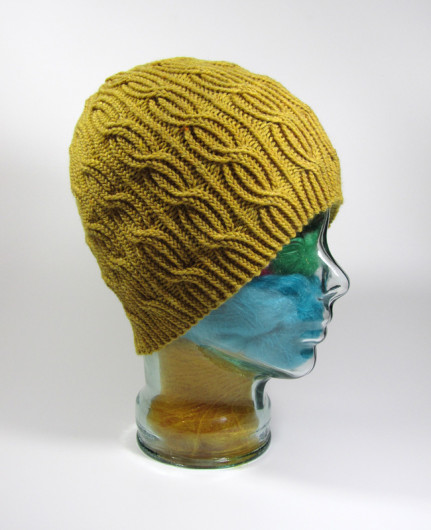This is Heather Zoppetti’s Mirtillo. I used Anzula Squishy. Squishy is a wonderful fingering weight in 80% merino, 10% cashmere goat, and 10% nylon that’s, well, delightfully squishy. I purchased the kit at a deep discount during a shop closeout. The pattern is a mix of garter stitch, simple mosaic work, with that cute picot edge added at the end.
The kit even included a matching shawl pin.
With any kit, my major concern is whether they’ve included enough yarn of each color to handle minor discrepancies in gauge. Not a problem. There was more than enough yarn in each “skeinette.” The only problem was that the pattern included in the kit was printed at a font-size and color that had me scratching my head. It was printed in gray. And the font size was about 6 point! Even young eyes would have been foiled. We were able to scan the pattern and then enlarge it. Otherwise, Mirtillo would not have been.
Take another look at this pretty.

It’s an itty bitty thing, though. The designer puts the dimensions at 19 inches at the wide point by 49 inches from end to end. I blocked mine as sternly as I felt wise and ended up at 17 inches by 47 inches. Either way, this is a small thing. And although I’m short I am not small. As much as I love the colors and pattern, I haven’t made up my mind yet if this one’s for me. It feels like a neckerchief and I’m not sure that’s a good look for me.
Mirtillo is only partly blue, but this next knit gives a full out blue experience in my version. It’s Assia Brill’s Distitch Edge Scarf. Brill says “distitch” is a new knitting concept.
I was skeptical that there was really anything new in the knitting universe that would edge a garter stitch scarf. But after watching this video, I was convinced Brill’s actually on to something new. Not only is it new, it’s super-easy. Check out this closer look at the result.
I declare it simply beautiful. I knit mine in Aran weight Simplinatural by HiKoo. The edge stitch is apparently just the tip of the iceberg for this new technique. Brill released an entire book devoted to it.
Try it, I predict you’ll like it!
And now, for something quite predictable. Dishcloths! This one is “Maryanne’s” Modified Feather and Fan cloth, available here:
I never met a feather and fan I didn’t think was very cool. So much bang for the buck. Well, the unbuck, actually, because the pattern is free. My cloth is knit in Knit Picks Dishie Multi.
Here’s another Amy Marie Vold set of slip stitch cloths.
They are Snow Two Alike, worked in Paintbox Yarns Cotton Aran. The yarn is fairly new to me. It compares favorably to Drops Paris and is a tad less rustic than Lily’s Sugar ‘n Cream. One of the things I often enjoy about Vold’s cloth is knitting them in sets, reversing the colors. The differences are sometimes striking. And they make a nice set for gifting.
If you’re not a dishcloth fan, and let’s face it knitters fall into two groups in that regard, you’re tuning out by now. People either hate to knit dishcloths, consider them a waste of yarn, and unsanitary to boot. Or they passionately love knitting them, are constantly on the hunt for new patterns, and have a drawer full of them. I am of the latter group.
These three are each knit in Knit Picks Dishie Multie. The top is Jeanne Breckelman’s Easy Columns Washcloth. The one on the bottom right is Linda Smith’s Feather and Fan Dishcloth. And the bottom left is Deb Buckingham’s Marbles & Jacks. The first two are freebies.
Seeing how the variegated performs in different situations is interesting. The columns cloth on steroids would make for a great scarf or wrap. If you haven’t seen the technique before I won’t spill the beans. But the columns are just knits and purls, though you end up with a garter stitch feel to the pattern.
This next DK-weight blue beauty is Lina, by Johanna of Joko Knits. I’ve knit Lina twice before. And I will knit it again. More than 2000 Ravelers have had lively discussions about how this twisted cable NOT brioche pattern works. I knit it, as the pattern is written, except that I needed to work with a cable needle. I’ve written before about how to translate the directions to work with a cable needle. I didn’t invent those directions. They are all over project pages and at my blog entry with my earlier knits. Bottom line? Knitters need to simply trust that the pattern is correct and all will be well.
Some have tried to modify the top. I knit this one just as Johanna directed. I think it works best. It gets a bit disorganized at the very end. But it also retains the loping twisted cables almost to the very end. I’ve never learned brioche knitting. Barking and burping just never proved appetizing even though I’ve drooled over many a brioche design. To me, Lina is brioche-like. Without the extra calories of the original.
















